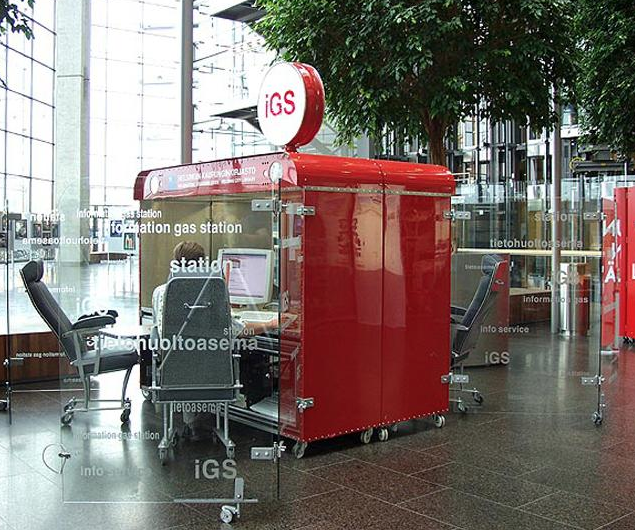What is informetion logistics? or, the spirit of the IoT ethics


情報ロジスティクスを通したソーシャルイノベーション
What is informetion logistics? or, the spirit of the IoT ethics


【定義】
調査研究をおこなっている〈現場〉に書籍や論文や参考資料、ときには研究維持のた めの食糧や栄養剤、さらにはリラックスのための音楽、さらには情報そのものであるスタッフなどを送り、逆〈現場〉からす でに利用した後の書籍や論文や参考資料を 引き取り、それを必要とするところに再配分するためのストック・プールを用意し、〈現場〉でお こなう調査研究を効果的に継続させるための補給手段、ひいては、それについて研究する学問である(→「情報ロ ジスティクス」)。
これを書いた時代(1998 年)当時、Amazonのサービスは、 まだ限定的 で、洋書もさまざまな通販サービスなどに依存する時代だった。しかし、いまやAmazonで扱う商品の種類は、一説には数百万種以上と言われている。つま り、お金があれば、この[広義の]情報ロジスティクスの理想は現実に達成されていると言える。
資本主義社会の市場メカニズ ムがいかに消費者の物欲を 満た すことに洗練された手段と発達したとはいえ、今度は逆に、モノに囲まれ、さまざまな情報が瞬時にICTを通して手に入るとしたら、それを当たり前とする裕 福な若者がでてきたとしても不思議ではない。それよりも、そのようなことを拒否するロハス系の人たちも登場するだろう。
また、情報や物質の豊かさを享受することを 本質的な目的を 失うと、それ事態に無関心になり、刹那的に生きるようになる。欲望と充足の関係は、つねに、前者のほうが過大でないと、社会がまわらないというこまった現 象もある——それゆえ、そのアンチテーゼとして持続可能社会という命題すら登場するわけである。
しかも消費は欲望を 再生産する——マルクス『経済学批判』
さて、2017年にジョン・ポールフリーの 『ビ ブリオ・テッ ク』を読んでいたら、フィンランドのヘルシンキの図書館の司書の人たちが、情報ガソリンスタ ンド(iGS)というプロジェクトに取り組んでいることを知っ た。iGSの取り組みを知るためにリンクを張っておく。
【課題】情報ロジスティクスを通したソーシャル イノベーション
「ソーシャル・イノベーションすなわち社会イノベー ション(Social
Innovation)は、デザイン可能であり、それが実現されるためには、さまざまな実証実験が試みられ、また、安心安全な管理技術
として確立され、そして、人びとが実際に使うことで、以前よりも「びっ くりし、わく
わくするような新しい出来事」だと認知されるようになれば、私たちはそれを社会イノベーションと呼んでもよいだろうと言うことだ」
++

●情報資源論
「情報資源は、それぞれの情報がコミュニ ケーションのネットワー クをつくる。そして、情報資源は、流通することで価値を生み出す。すなわちコミュニケーションの形式に情報資源の価値は依存す る。その要素を列挙してみよう。 1.生産 2.業績評価システム 3.公開 4.蓄積(インターネット、図書館、研究者の身体) 5.流通価値システム(利潤:知的所有権,認知度:資金および 人的資源の召喚)」(→「情報ロジスティク ス」)
●派生問題01としてのIoT
「IoT(アイ・オー・ティー)とは、 Internet of Things、IoT、つまり「モノのインターネット」「物のインターネット」(ウィキの訳語)あるいは「諸事物のインターネット」(著者の用語)のこと である。アイオーティとは、モノの流通・売買がインターネットによる繋がる現象のことである。(→「IoT(アイ・オー・ティー)」)」
The Internet of things (stylised Internet of Things or IoT) is the internetworking of physical devices, vehicles (also referred to as "connected devices" and "smart devices"), buildings and other items—embedded with electronics, software, sensors, actuators, and network connectivity that enable these objects to collect and exchange data.[1][2][3] In 2013 the Global Standards Initiative on Internet of Things (IoT-GSI) defined the IoT as "the infrastructure of the information society."[3] The IoT allows objects to be sensed and/or controlled remotely across existing network infrastructure,[4] creating opportunities for more direct integration of the physical world into computer-based systems, and resulting in improved efficiency, accuracy and economic benefit.[5][6][7][8][9][10] When IoT is augmented with sensors and actuators, the technology becomes an instance of the more general class of cyber-physical systems, which also encompasses technologies such as smart grids, smart homes, intelligent transportation and smart cities. Each thing is uniquely identifiable through its embedded computing system but is able to interoperate within the existing Internet infrastructure. Experts estimate that the IoT will consist of almost 50 billion objects by 2020.[11]- Wikipedia
「IoTは早くも生産性を押し上げ、多くの
財やサービスを生産 する限界費用を
ほぼゼロに近づけ、それらの財やサービスを実質的に無料にし、出現しつつある協働型コモンズでシェア可能にしている。その結果、企業の収益
が枯渇したり、財産権の効力が弱まったり、希少性に基づく経済が潤沢さに基づく経済に徐々に道を譲ったりしている」——リフキン,ジェレミー『限界費用ゼロ社会』柴田裕之訳、p.25,
NHK出版、2015年。
●派生問題としての兵站(Military Logistics)
"Military
logistics
is the discipline of planning and carrying out the movement, supply,
and maintenance of military forces. In its most comprehensive sense, it
is those aspects or military operations that deal with:[1]; Design, development, acquisition, storage,
distribution, maintenance, evacuation, and disposition of materiel.
Transport of personnel.
Acquisition or construction, maintenance, operation, and disposition of
facilities.
Acquisition or furnishing of services.
Medical and health service support."- Military logistic.
■歴史
”The word "logistics" is derived from the Greek adjective logistikos meaning "skilled in calculating". The first administrative use of the word was in Roman and Byzantine times when there was a military administrative official with the title Logista. At that time, the word apparently implied a skill involved in numerical computations. Historically supplies for an army were first acquired by foraging or looting, especially in the case of food and fodder, although if traveling through a desolated region or staying in one place for too long resources could quickly be exhausted. A second method was for the army to bring along what was needed, whether by ships, pack animals, wagons or carried on the backs of the soldiers themselves. This allowed the army some measure of self-sufficiency, and up through to the 19th century most of the ammunition a soldier needed for an entire campaign could be carried on their person. However, this method led to an extensive baggage train which could slow down the army's advance and the development of faster-firing weapons soon outpaced an army's ability to supply itself. Starting with the Industrial Revolution new technological, technical and administrative advances led to a third method, that of maintaining supplies in a rear area and transporting them to the front. This led to a "logistical revolution" which began in the 20th century and drastically improved the capabilities of modern armies while making them highly dependent on this new system.[2][3]”- Military logistic.
「アントワーヌ=アンリ・ジョミニは、戦争
の理論を構成する三つの要素として戦略と戦術に並んで兵站を位置づけており、ソープ(G. C.
Thorpe)は戦争を演劇の類推から役者が立つ舞台を準備することが兵站の役割であると考察している。彼らの説明は兵站が軍事理論において補助的なもの
ではなく、むしろ主要な地位を占めるものであり、それは、軍事作戦の遂行を基礎付けることを示している。「戦争のプロは兵站を語り、戦争の素人は戦略を語
る」という格言はそのような兵站の重要性を端的に強調したものであると言える」(→石津朋之「解説
マーチン・ファン・クレフェルトとその戦争観」マーチン・ファン・クレフェルト『補給戦』,中公文庫,pp.399-417,2006年)
リンク
文献
その他の情報